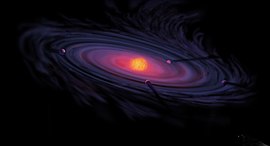
Back تشكل المجموعة الشمسية وتطورها Arabic Formación y evolución del sistema solar AST Паходжаньне Сонечнай сыстэмы BE-X-OLD সৌরজগতের জন্ম ও বিবর্তন Bengali/Bangla Formació i evolució del sistema solar Catalan Vznik a vývoj sluneční soustavy Czech Solsystemets dannelse og udvikling Danish Entstehung des Sonnensystems German Formation and evolution of the Solar System English Formación y evolución del sistema solar Spanish

The formation and evolution of the Solar System describes how the Solar System began, and how it changed.
About 4.6 billion years ago, there was a large cloud of gas nearby our area of space. All things with mass come together, or gravitate towards one another. This pulled all the gas towards the center. Eventually the pressure at the center raised the temperature so that hydrogen atoms fused together to make helium. This began the star we know as the Sun.
The process of how solar systems are created is called the nebular theory. However, the origin of the planets is not the same as the origin of the Sun. Not only is the Sun very much larger, but its make-up is quite different from the planets.
The spin of the planets around the Sun, and each around its own axis, was first caused by the original gas cloud having different density in different places. The spin increased because of the contraction under gravity (conservation of energy). So did the flatness of the Solar System's shape. As the collapse continued, conservation of angular momentum meant that the rotation accelerated.[1][2] This largely prevents the gas from sticking onto the central core (the future Sun). The gas is forced to spread outwards near its equatorial plane, forming a disk.[1][2]
Gravity caused the atoms in the Sun to become very close to each other. All this energy eventually made our Sun into a star. It gets its energy from changing its hydrogen into helium. That process is still in its early stages.
Because of the Sun's huge mass (99.86% of the whole mass of the Solar System), it has very strong gravity. The centrifugal force of the planets going round the Sun balances the gravitational pull of the Sun. The huge density at its core causes a fusion reaction which turns hydrogen into helium with the radiation of heat, light and other forms of electromagnetic radiation.
Rock and dust makes the terrestrial planets, their moons, asteroids and all other objects in the Solar System. The gas giant planets also do have rocky or metallic centres. This is known from the data-gathering by satellites. This rocky material cannot come from the Sun, because the Sun is all hydrogen and helium.
The next issue is: if the Sun turns hydrogen into helium, where do all the other elements come from? There is only one possible answer: these higher elements came from earlier generations of stars. Huge supernovas which exploded billions of years ago in the neighbourhood of the young Solar System produced the higher elements.
Huge stars run through their life cycle much faster than smaller stars. That is caused by the even higher pressures and temperatures inside them as compared with an average main sequence star like the Sun.[3][4]
- ↑ 1.0 1.1 Nakamoto, Taishi; Nakagawa, Yushitsugu (1994). "Formation, early evolution, and gravitational stability of protoplanetary disks". The Astrophysical Journal. 421: 640–650. Bibcode:1994ApJ...421..640N. doi:10.1086/173678.
- ↑ 2.0 2.1 Yorke, Harold W.; Bodenheimer, Peter (1999). "The formation of protostellar disks. III. The influence of gravitationally induced angular momentum transport on disk structure and appearance". The Astrophysical Journal. 525 (1): 330–342. Bibcode:1999ApJ...525..330Y. doi:10.1086/307867. S2CID 120983375. [arXiv:1008.2973v1 [astro-ph.EP] ]
- ↑ Charles H. Lineweaver 2001. An estimate of the age distribution of terrestrial planets in the Universe: quantifying metallicity as a selection effect. Icarus 151 (2): 307–313. [1]
- ↑ Williams J. 2010. The astrophysical environment of the solar birthplace. Contemporary physics. 51 (5): 381–396. [2]
© MMXXIII Rich X Search. We shall prevail. All rights reserved. Rich X Search